Anzac Day
| Anzac Day | |
|---|---|
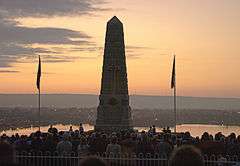 Anzac Day Dawn Service at Kings Park, Western Australia, 25 April 2009, 94th anniversary | |
| Observed by |
Australia New Zealand |
| Type | Commemorative, patriotic, historic |
| Significance | National day of remembrance and first landing of the Anzacs at Gallipoli |
| Observances | Dawn services, commemorative marches, remembrance services |
| Date | 25 April |
| Next time | 25 April 2017 |
| Frequency | Annual |
| Related to |
Remembrance Day (Commonwealth of Nations), Armistice Day, Veterans Day, Memorial Day |
Anzac Day /ˈænzæk/ is a national day of remembrance in Australia and New Zealand that broadly commemorates all Australians and New Zealanders "who served and died in all wars, conflicts, and peacekeeping operations" and "the contribution and suffering of all those who have served".[1][2] Observed on 25 April each year, Anzac Day was originally to honour the members of the Australian and New Zealand Army Corps (ANZAC) who fought at Gallipoli against the Ottoman Empire during World War I.
Anzac Day is also observed in the Cook Islands, Niue, Pitcairn Islands, and Tonga, and previously also as a national holiday in Papua New Guinea and Samoa.[3][4]
History
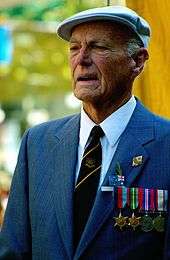
Anzac Day marks the anniversary of the first campaign that led to major casualties for Australian and New Zealand forces during the First World War. The acronym ANZAC stands for Australian and New Zealand Army Corps, whose soldiers were known as Anzacs. Anzac Day remains one of the most important national occasions of both Australia and New Zealand,[5] a rare instance of two sovereign countries not only sharing the same remembrance day, but making reference to both countries in its name. When war broke out in 1914, Australia and New Zealand had been dominions of the British Empire for thirteen and seven years respectively.
Gallipoli campaign
In 1915, Australian and New Zealand soldiers formed part of an Allied expedition that set out to capture the Gallipoli Peninsula to open the way to the Black Sea for the Allied navies. The objective was to capture Constantinople, the capital of the Ottoman Empire, which was an ally of Germany during the war. The ANZAC force landed at Gallipoli on 25 April, meeting fierce resistance from the Ottoman Army commanded by Mustafa Kemal (later known as Atatürk). What had been planned as a bold strike to knock the Ottomans out of the war quickly became a stalemate, and the campaign dragged on for eight months. At the end of 1915, the Allied forces were evacuated after both sides had suffered heavy casualties and endured great hardships. The Allied casualties included 21,255 from the United Kingdom, of which were some 4000 Irish soldiers from the Royal Irish Fusiliers, an estimated 10,000 dead soldiers from France, 8,709 from Australia, 2,721 from New Zealand, and 1,358 from British India. News of the landing at Gallipoli made a profound impact on Australians and New Zealanders at home and 25 April quickly became the day on which they remembered the sacrifice of those who had died in the war.
Though the Gallipoli campaign failed to achieve its military objectives of capturing Constantinople and knocking the Ottoman Empire out of the war, the actions of the Australian and New Zealand troops during the campaign bequeathed an intangible but powerful legacy. The creation of what became known as an "Anzac legend" became an important part of the national identity in both countries. This has shaped the way their citizens have viewed both their past and their understanding of the present.
Foundations of Anzac Day
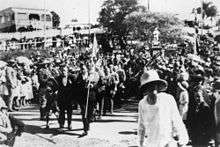
On 30 April 1915, when the first news of the landing reached New Zealand, a half-day holiday was declared and impromptu services were held.[6]
In South Australia, Australia's first built memorial to those killed in the Dardanelles was unveiled by the South Australian Governor on "Wattle Day", 7 September 1915, just over four months after the first landings. The monument was originally in an area called "Wattle Grove" on Sir Lewis Cohen Avenue in the South Parklands but was later moved to a lawned area off South Terrace near the junction with Anzac Highway. Remnant seedlings of the original wattles still grow in "Wattle Grove".[7] Also in South Australia, Eight Hour Day, 13 October 1915, was renamed "Anzac Day" and a carnival was organised to raise money for the Wounded Soldiers Fund.[8]
The date 25 April was officially named Anzac Day in 1916; in that year it was marked by a wide variety of ceremonies and services in Australia and New Zealand, including a commemorative march through London involving Australian and New Zealand troops. In New Zealand it was gazetted as a half-day holiday.[6] Australian Great War battalion and brigade war diaries show that on this first anniversary, units including those on the front line, made efforts to solemnise the memory of those who were killed this day twelve months previously. A common format found in the war diaries by Australian and New Zealand soldiers for the day commenced with a dawn requiem mass, followed mid-morning with a commemorative service, and after lunch organised sports activities with the proceeds of any gambling going to Battalion funds. This occurred in Egypt as well.
In Queensland on 10 January 1916, Canon David John Garland was appointed the honorary secretary of the Anzac Day Commemoration Committee of Queensland (ADCCQ) at a public meeting which endorsed 25 April as be the date promoted as “Anzac Day” in 1916 and ever after. Devoted to the cause of a non-denominational commemoration that could be attended by the whole of Australian society, Garland worked amicably across all denominational divides, creating the framework for Anzac Day commemorative services.[9] Garland is specifically credited with initiating the Anzac Day march, the wreath-laying ceremonies at memorials and the special church services, the two minutes silence, and the luncheon for returned soldiers.[10] Garland intended the silence was used in lieu of a prayer to allow the Anzac Day service to be universally attended, allowing attendees to make a silent prayer or remembrance in accordance with their own beliefs. He particularly feared that the universality of the ceremony would fall victim to religious sectarian disputes.[11]
In London, over 2,000 Australian and New Zealand troops marched through the streets of the city.[12] A London newspaper headline dubbed them "The Knights of Gallipoli". Marches were held all over Australia in 1916; wounded soldiers from Gallipoli attended the Sydney march in convoys of cars, accompanied by nurses. Over 2,000 people attended the service in Rotorua.[6] For the remaining years of the war, Anzac Day was used as an occasion for patriotic rallies and recruiting campaigns, and marches of serving members of the AIF were held in most cities. From 1916 onwards, in both Australia and New Zealand, Anzac memorials were held on or about 25 April, mainly organised by returned servicemen and school children in cooperation with local authorities.

Anzac Day was gazetted as a public holiday in New Zealand in 1920, through the Anzac Day Act, after lobbying by the New Zealand Returned Soldiers’ Association,[13] the RSA.[14] In Australia at the 1921 State Premiers' Conference, it was decided that Anzac Day would be observed on 25 April each year. However, it was not observed uniformly in all the states.
During the 1920s, Anzac Day became established as a National Day of Commemoration for the 60,000 Australians and 18,000 New Zealanders who died during the war. The first year in which all the Australian states observed some form of public holiday together on Anzac Day was 1927. By the mid-1930s, all the rituals now associated with the day—dawn vigils, marches, memorial services, reunions, sly two-up games—became part of Australian Anzac Day culture. New Zealand commemorations also adopted many of these rituals, with the dawn service being introduced from Australia in 1939.[14]
Anzac Day since World War II
With the coming of the Second World War, Anzac Day became a day on which to commemorate the lives of Australians and New Zealanders lost in that war as well and in subsequent years. The meaning of the day has been further broadened to include those killed in all the military operations in which the countries have been involved.
Anzac Day was first commemorated at the Australian War Memorial in 1942, but, due to government orders preventing large public gatherings in case of Japanese air attack, it was a small affair and was neither a march nor a memorial service. Anzac Day has been annually commemorated at the Australian War Memorial ever since.[5]
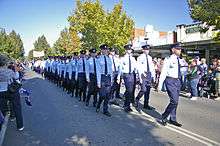
In New Zealand, Anzac Day saw a surge in popularity immediately after World War II. However this was short-lived, and by the 1950s many New Zealanders had become antagonistic or indifferent towards the day. Much of this was linked to the legal ban on commerce on Anzac Day, and the banning by many local authorities of sports events and other entertainment on the day. Annoyance was particularly pronounced in 1953 and 1959, when Anzac Day fell on a Saturday. There was widespread public debate on the issue, with some people calling for the public holiday to be moved to the nearest Sunday or abolished altogether. In 1966 a new Anzac Day Act was passed, allowing sport and entertainment in the afternoon.[15]
From the 1960s, but especially in the 1970s and 1980s, Anzac Day became increasingly controversial in both Australia and New Zealand. Protests against the Vietnam War were common Anzac Day occurrences during the 1960s and 1970s.[16][17] In 1967, two members of the left-wing Progressive Youth Movement in Christchurch staged a minor protest at the Anzac Day ceremony, laying a wreath protesting against the Vietnam War. They were subsequently convicted of disorderly conduct. In 1978, a women's group laid a wreath dedicated to all the women raped and killed during war, and movements for feminism, gay rights, and peace used the occasion to draw attention to their respective causes at various times during the 1980s.[18] In the 1980s, Australian feminists used the annual Anzac Day march to protest against rape and violence in war and were banned from marching.[19][20]
From about the late 1980s, however, there was an international resurgence of interest in World War I and its commemorations. Anzac Day attendances rose in Australia and New Zealand, with young people taking a particular interest. Protests and controversy became much rarer.
Until 1981 Papua New Guinea commemorated its war dead on Anzac Day; however, since then Remembrance Day has been observed on 23 July, the date of the first action of the Papuan Infantry Battalion against the Japanese at Awala in 1942 during the Kokoda Track campaign.[21]
Revival
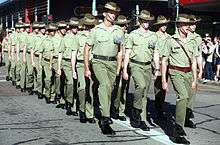
Following Australia's involvement in the Vietnam War, interest in Anzac Day reached its lowest point. On 26 April 1975, The Australian newspaper covered the passing of Anzac Day in a single story.[22] However, in recent years Anzac Day has drawn record crowds,[23] with an increasing number of those attending being young Australians,[24][25] many of whom attend ceremonies swathed in Australian flags, wearing green and gold T-shirts and beanies and with Australian flag tattoos imprinted on their skin.[26][27][28][29] This phenomenon has been perceived by some as a reflection of the desire of younger generations of Australians to honour the sacrifices made by the previous generations.[30]
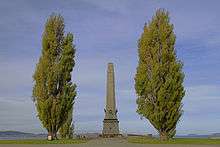
Australians and New Zealanders recognise 25 April as a ceremonial occasion to reflect on the cost of war and to remember those who fought and lost their lives for their country. Commemorative services and marches are held at dawn, the time of the original landing, mainly at war memorials in cities and towns across both nations and the sites of some of Australia and New Zealand's more-recognised battles and greatest losses, such as Villers-Bretonneux in France[31] and Gallipoli in Turkey.[32]
One of the traditions of Anzac Day is the 'gunfire breakfast' (coffee with rum added) which occurs shortly after many dawn ceremonies, and recalls the 'breakfast' taken by many soldiers before facing battle. Later in the day, ex-servicemen and ex-servicewomen meet and join in marches through the major cities and many smaller centres.
Dawn service
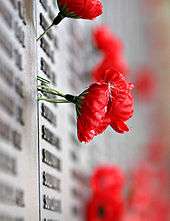
After the First World War, returned soldiers sought the comradeship they felt in those quiet, peaceful moments before dawn. With symbolic links to the dawn landing at Gallipoli, a dawn stand-to or dawn ceremony became a common form of Anzac Day remembrance during the 1920s.
The first official dawn service was held at the Sydney Cenotaph in 1927. Dawn services were originally very simple and followed the operational ritual; in many cases they were restricted to veterans only. The daytime ceremony was for families and other well-wishers and the dawn service was for returned soldiers to remember and reflect among the comrades with whom they shared a special bond.
Before dawn the gathered veterans would be ordered to "stand-to" and two minutes of silence would follow. At the start of this time a lone bugler would play the Last Post and then concluded the service with Reveille. In more recent times the families and young people have been encouraged to take part in dawn services, and services in Australian capital cities have seen some of the largest turnouts ever. Reflecting this change, the ceremonies have become more elaborate, incorporating hymns, readings, pipers and rifle volleys. Others, though, have retained the simple format of the dawn stand-to, familiar to so many soldiers.

Typical modern dawn services follow a pattern that is now familiar to generations of Australians, containing the following features: introduction, hymn, prayer, an address, laying of wreaths, recitation, the playing of the Last Post, a minute of silence, Reveille, and the playing of both the New Zealand and Australian national anthems. At the Australian War Memorial, following events such as the Anzac Day and Remembrance Day services, families often place artificial red poppies beside the names of relatives on the Memorial's Roll of Honour. In Australia, sprigs of rosemary are often worn on lapels[33] and in New Zealand poppies have taken on this role.[34]
Commemoration
In Australia and New Zealand, Anzac Day commemoration features solemn "Dawn Services" or "Dawn Marches", a tradition started in Albany, Western Australia on 25 April 1923 and now held at war memorials around both countries, accompanied by thoughts of those lost at war to the ceremonial sounds of the Last Post on the bugle. The fourth stanza of Laurence Binyon's poem For the Fallen (known as the "Ode of Remembrance", or simply as "the Ode") is often recited.
Australia
Anzac Day is a national public holiday and is considered by many Australians to be one of the most solemn days of the year. Marches by veterans from all past wars, as well as current serving members of the Australian Defence Force and Reserves, with allied veterans as well as the Australian Defence Force Cadets and Australian Air League and supported by members of Scouts Australia, Guides Australia, and other uniformed service groups, are held in cities and towns nationwide. The Anzac Day March from each state capital is televised live with commentary. These events are generally followed by social gatherings of veterans, hosted either in a public house or in an RSL club, often including a traditional Australian gambling game called two-up, which was an extremely popular pastime with ANZAC soldiers. In most Australian states and territories, gambling is forbidden outside of licensed venues. However, due to the significance of this tradition, two-up is legal only on Anzac Day.
Despite federation being proclaimed in Australia in 1901, it is argued that the "national identity" of Australia was largely forged during the violent conflict of World War I,[26][35] and the most iconic event in the war for most Australians was the landing at Gallipoli. Dr. Paul Skrebels of the University of South Australia has noted that Anzac Day has continued to grow in popularity;[36] even the threat of a terrorist attack at the Gallipoli site in 2004[37] did not deter some 15,000 Australians from making the pilgrimage to Turkey to commemorate the fallen ANZAC troops.[38]
Although commemoration events are always held on 25 April, most states and territories currently observe a substitute public holiday on the following Monday when Anzac Day falls on a Sunday. When Anzac Day falls on Easter Monday, such as in 2011, the Easter Monday holiday is transferred to Tuesday.[39] This followed a 2008 meeting of the Council for the Australian Federation in which the states and territories made an in principle agreement to work towards making this a universal practice.[40] However, in 2009, the Legislative Council of Tasmania rejected a bill amendment that would have enabled the substitute holiday in that state.[41]
Australian postage stamps
Australia Post has issued stamps over the years to commemorate Anzac Day, the first being in 1935 for the 20th anniversary of the Gallipoli landings.
The full list of issued stamps is as follows:
- 1935 – 20th Anniversary (2 values) 2d Red and 1/- Black featuring the London Cenotaph.
- 1955 – the then current 3½d Purple Nursing commemorative stamp was privately overprinted with the words "ANZAC 1915–1955 40 YEARS LEST WE FORGET" and a value ranging from 1d to £1 was also added which was the fundraising amount in addition to the legal cost of stamp of which the denomination was 3½d. Eight values were issued and were intended to raise funds for the Anzac commemorations. It is believed these stamps were authorised by the secretary of a leading Melbourne RSL club.
- 1965 – 50th Anniversary (3 values) 5d Khaki, 8d Blue and 2/3 Maroon featuring Simpson and his donkey.
- 1990 – 75th Anniversary (5 values) 41¢ x 2, 65¢, $1, and $1.10 all featuring various Anzac themes.
- 2000 – ANZAC legends (4 values) 45¢ x 4 featuring Walter Parker, Roy Longmore, Alec Campbell and the Anzac medal.
Australian football
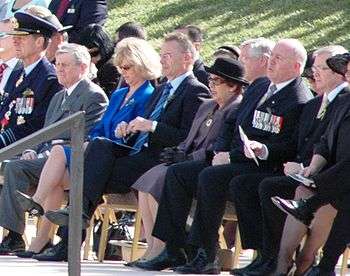
During many wars, Australian rules football matches have been played overseas in places like northern Africa, Vietnam, and Iraq as a celebration of Australian culture and as a bonding exercise between soldiers.[42][43][44]
The modern-day tradition began in 1995 and is played every year between traditional AFL rivals Collingwood and Essendon at the Melbourne Cricket Ground. This annual match is often considered the biggest of the AFL season outside of the finals, sometimes drawing bigger crowds than all but the Grand Final,[45] and often selling out in advance. A record crowd of 94,825 people attended the inaugural match in 1995.[46][47][48] The Anzac Medal is awarded to the player in the match who best exemplifies the Anzac spirit – skill, courage, self-sacrifice, teamwork and fair play. Collingwood hold the advantage 11 wins to 8 with one draw (in the inaugural year, 1995).
In 2013, St Kilda and the Sydney Swans played an Anzac Day game in Wellington, New Zealand, the first AFL game played for premiership points outside of Australia.[49] The winning team, Sydney, were presented with the inaugural Simpson-Henderson Trophy by the Prime Minister of New Zealand. The trophy was named after two notable Anzac soldiers: John Simpson Kirkpatrick and Richard Alexander Henderson.[50]
Rugby League football
Beginning in 1997, the Anzac Test, a rugby league test match, has commemorated Anzac Day, though it is typically played a week prior to Anzac Day. The match is always played between the Australian and New Zealand national teams, and has drawn attendances of between 20,000 and 45,000 in the past.
Domestically, matches have been played on Anzac Day since 1927 (with occasional exceptions). Since 2002, the National Rugby League (NRL) has followed the lead of the Australian Football League, hosting a match between traditional rivals St George Illawarra Dragons and the Sydney Roosters each year to commemorate Anzac Day in the Club ANZAC Game, although these two sides had previously met on Anzac Day several times as early as the 1970s. Since 2009, an additional Anzac Day game has been played between the Melbourne Storm and New Zealand Warriors.
New Zealand

New Zealand's Commemoration of Anzac Day[51] is similar. The number of New Zealanders attending Anzac Day events in New Zealand, and at Gallipoli, is increasing. For some, the day adds weight to the idea that war is futile.[52]
Dawn Marches and other memorials nationwide are typically attended by the New Zealand Defence Force, the New Zealand Cadet Forces, members of the New Zealand Police, New Zealand Fire Service, Order of St John Ambulance Service (Youth and Adult Volunteers) as well as Scouting New Zealand, GirlGuiding New Zealand and other uniformed community service groups including in most places the local Pipe Band to lead or accompany the March, and sometimes a Brass Band to accompany the hymns.
Anzac Day now promotes a sense of unity, perhaps more effectively than any other day on the national calendar. People whose politics, beliefs and aspirations are widely different can nevertheless share a genuine sorrow at the loss of so many lives in war.
Paper poppies are widely distributed by the Returned Services Association and worn as symbols of remembrance. This tradition follows that of the wearing of poppies on Remembrance Sunday in other Commonwealth countries.[53]
The day is a public holiday in New Zealand. Shops are prohibited from opening before 1 pm as per the Anzac Day Act 1966. A prior Act passed in 1949 prevented the holiday from being "Mondayised" (moved to the 26th or 27th should the 25th fall on a weekend),[54] although this drew criticism from trade unionists and Labour Party politicians.[55] In 2013, a member's bill introduced by Labour MP David Clark to Mondayise Anzac Day and Waitangi Day passed, despite opposition from the governing National Party.[56]
Turkey
In Turkey the name "ANZAC Cove" was officially recognised by the Turkish government on Anzac Day in 1985. In 1934, Kemal Atatürk delivered the following words to the first Australians, New Zealanders and British to visit the Gallipoli battlefields. This was later inscribed on a monolith at Ari Burnu Cemetery (ANZAC Beach) which was unveiled in 1985. The words also appear on the Kemal Atatürk Memorial, Canberra, and the Atatürk Memorial in Wellington:[57]
- "Those heroes that shed their blood
And lost their lives.
You are now lying in the soil of a friendly country.
Therefore rest in peace.
There is no difference between the Johnnies
And the Mehmets to us where they lie side by side
Here in this country of ours.
You, the mothers,
Who sent their sons from far away countries
Wipe away your tears,
Your sons are now lying in our bosom
And are in peace
After having lost their lives on this land they have
Become our sons as well."[58]
In 1990, to mark the 75th anniversary of the Gallipoli landing, Government officials from Australia and New Zealand (including Australian Prime Minister Bob Hawke[59][60] and New Zealand Governor-General Paul Reeves[61]) as well as most of the last surviving Gallipoli veterans, and many Australian and New Zealand tourists travelled to Turkey for a special Dawn Service at Gallipoli. The Gallipoli Dawn Service was held at the Ari Burnu War Cemetery at Anzac Cove, but the growing numbers of people attending resulted in the construction of a more spacious site on North Beach, known as the "Anzac Commemorative Site" in time for the year 2000 service.
A ballot was held to allocate passes for Australians and New Zealanders wishing to attend Anzac Day commemorations at Gallipoli in 2015. Of the 10,500 people that could be safely, securely and comfortably accommodated at the Anzac Commemorative Site, in 2015 this comprised places for 8,000 Australians, 2,000 New Zealanders and 500 official representatives of all nations involved in the Gallipoli campaign. Only those who received an offer of attendance passes attended the commemorations in 2015.[62]
Other overseas ceremonies
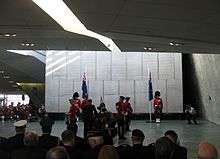
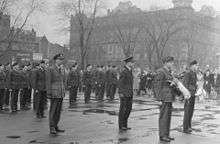
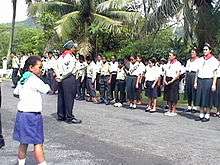
Antarctica
- Scott Base holds a ceremony honouring the fallen on Anzac Day. Americans from the nearby McMurdo Station are often invited.[63]
Belgium
- In Ypres – Belgium, the ANZAC-Day Ceremony is held at the Menin Gate at 11 A.M.
Canada
- In Canada, His Excellency the Right Honourable David Johnston, Governor General and Commander-in-Chief of Canada, marked the 100th anniversary of Anzac Day during a ceremony held at the Canadian War Museum in Ottawa, Ontario on 25 April 2015. "'It will be my honour, as commander-in-chief of Canada, to pay tribute to the 8 709 Australian and 2 779 New Zealand soldiers who were killed during the Gallipoli Campaign that began on April 25, 1915. A century later, we remember these soldiers, as well as the Canadians who fought alongside them in that terrible war,' His Excellency said. 'Lest we forget.'"[64] Other Canadian communities also mark Anzac Day, generally with an Anzac dawn requiem mass, followed by an Anzac dinner, and a film showing of Gallipoli.
- In Newfoundland, Canada, the Gallipoli offensive is commemorated each year on 25 April by the Royal Newfoundland Regiment who hold a march from Government House through the streets of St. John's ending at the National War Memorial. Members of both the Australian and New Zealand armed forces are invited each year to participate in the march and wreath laying ceremonies.
- Calgary has had a Cenotaph Service annually at Central Park with participation from the local military.[65]
- In Winnipeg, Manitoba Anzac service is held at the Royal Aviation Museum of Western Canada by the Down Under Club of Winnipeg.
- In Edmonton, Alberta Anzac dawn service is held annually at Edmonton City Hall Cenotaph.
- In London, Ontario Anzac service is held at Wolseley Barracks, Royal Canadian Regiment (RCR) Memorial, 701 Oxford Street East, London.
- In Toronto, Ontario, Anzac service is held at the Armour Heights Officers’ Mess, Canadian Forces College.
- In Vancouver, British Columbia ANZAC Service is held annually at Victory Square, Vancouver.[66]
Cyprus
- In Nicosia, the ANZAC Day dawn service is held at the Nicosia War Cemetery (Waynes Keep) at 05:00. The ceremony is usually attended by expatriates from both countries and by high-ranking officials of the UN peacekeeping mission deployed on the island.
Egypt
- In Cairo, Egypt, Anzac Day is remembered by the expatriate New Zealand and Australian communities with a dawn ceremony held at the Old Cairo War Graves Cemetery, Abu Seifen Street, Old Cairo. New Zealand and Australian Embassies rotate hosting the service.
United Kingdom
- In London, England, a 5 am Dawn Service is held, alternating between the Australian War Memorial, and the more recently constructed New Zealand War Memorial, both of which are at Hyde Park Corner. The day is also marked by a 9 am Wreath Laying Ceremony and service at the Gallipoli Memorial in the crypt of St Paul's Cathedral[67] and an 11 am Wreath Laying Ceremony and Parade at The Cenotaph, Whitehall, both of which are attended by official representatives and veterans associations of Australia, New Zealand, the United Kingdom and other countries. The Wreath Laying Ceremony at the Cenotaph is directly followed by a Service of Commemoration and Thanksgiving at Westminster Abbey.[68] The Dawn Service, ceremony at the Cenotaph and the Service of Commemoration and Thanksgiving are usually attended by a member of the Royal Family representing the Queen, and by the High Commissioners of Australia and New Zealand.[69] Anzac Day has been officially observed in London since 1916, when King George V and Queen Mary attended the first commemorative service at the Abbey.[70]
- In Tetbury, Gloucestershire, England, a March is held on the nearest Sunday to Anzac Day. The service is held in a graveyard with several war graves of service men from Australia and New Zealand. Veterans and cadets from the local ATC squadron attend.
- In Oxford, Oxfordshire, England, an Anzac Day service is organised by the Oxford University Australia New Zealand Society. In 2015 the service was held at the University Church on 25 April, followed by dinner in Somerville College Hall.[71] Representatives of the Australian and New Zealand High Commissions attend and Australian, New Zealand, and Turkish students are all involved in the service.
- A service of remembrance to commemorate Anzac Day and Gallipoli is held at the National Memorial Arboretum in Staffordshire, England, UK. This commences with a service in the chapel followed by wreath laying at the Gallipoli memorial.
France
- In France in the towns of Le Quesnoy and Longueval[72] and in the town of Villers-Bretonneux (on the next closest weekend) because on 25 April 1918, the village of Villers-Bretonneux was liberated by the Anzacs. The Australian Government holds an annual dawn service[31] at the Australian National Memorial just outside the small town of Villers-Bretonneux.
- In French Polynesia, Anzac Day has been commemorated with an official ceremony held in Papeete since 2006.[73] The 2009 ceremony was attended by French Polynesia President Oscar Temaru, who praised the "courage and liberty" of Australian and New Zealand soldiers in a statement.[73]
Germany
- In Germany, Anzac Day is commemorated in Berlin, at the Commonwealth Kriegsgräber, Charlottenburg. (Commonwealth War Graves).[74]
Hong Kong
- In Hong Kong, a simple dawn commemorative service is held at The Cenotaph (Hong Kong) in Central, with a member of the Hong Kong Police Band playing the Last Post and Reveille from the balcony of the nearby Hong Kong Club.[75]
Ireland
- In Ireland, Anzac Day is remembered by the expatriate New Zealand and Australian communities. In the absence of an official World War I remembrance, and in honour of Irish soldiers who fought and perished in the Dardanelles and elsewhere, Anzac Day commemorations are also attended by members of veterans groups and historical societies, including the Royal Dublin Fusiliers, O.N.E.T., the Royal British Legion, UN Veterans, and more. Since the mid-1980s, an evening service has been organised by the New Zealand-Ireland Association,[76] which currently takes place in St Ann's Church, Dawson St, Dublin 2. For the 90th anniversary in 2005, a daylight service was held for the first time in the re-furbished Grangegorman Military Cemetery, Dublin 7. A Turkish Hazel tree, planted by the Ambassadors of Australia, New Zealand and Turkey, commemorates this occasion. It can be found to the south of the limestone Memorial Wall. Since this date, a dawn service has been held at this location. At the Ballance House in County Antrim, the official New Zealand centre in Northern Ireland, a midday Anzac reception and act of remembrance takes place.
Israel
- In Israel, a commemorative service is held at Jerusalem British War Cemetery on Anzac Day, attended by the ambassadors of Australia and New Zealand.
Kiribati
- In Kiribati, Anzac Day is commemorated at the Coast Watchers Memorial on the islet of Betio, Tarawa, hosted by the New Zealand and Australian High Commissions.
Malaysia
- In Kuala Lumpur and Sandakan, Malaysia,[77] Anzac Day is a memorial day to honour the Australian, British, New Zealand and local soldiers who perished during the Second World War. A commemorative service will be held like Dawn Service and Gunfire Breakfast.
Malta
- In Malta Anzac day is commemorated at dawn in Floriana at the Anzac Monument at the Argotti Gardens.
Poland
- In Warsaw every year, a joint ceremony is held with Australian, New Zealand and Polish representatives at the Tomb of the Unknown Soldier in Piłsudski Square.[78]
Sudan
- In South Sudan, Anzac Day is commemorated in the capital Juba at a dawn service at DaVinci by the Nile River by expats and friends of Australia alike.
Thailand
- In Kanchanaburi, Thailand, a dawn service is held at Hellfire Pass, a rock cutting dug by allied Prisoners of War and Asian labourers for the Thai-Burma Railway. This cutting is where the greatest number of lives were lost during railway construction. The dawn service is followed by a "gunfire breakfast" (coffee with a shot (or two) of rum) recalling the 'breakfast' taken by many soldiers before facing battle. At 11 am a second ceremony is held at the main POW cemetery in the city of Kanchanaburi, where 6,982 POWs are buried, mostly British, Australian, Dutch and Canadians. Over the years, both services have been attended by some Anzac ex-POWs and their families travelling from Australia, as well as ambassadors from the Australian and New Zealand consulates, the Kanchanaburi Provincial Governor, and others. The closest Saturday to Anzac Day also sees the ex-POWs attend an Australian Rules football match between the Thailand Tigers AFL club and a team invited from neighbouring Asian countries.
United States
- In the United States, Anzac Day is commemorated at the Los Angeles National Cemetery in Westwood, California. The New Zealand and Australian Consulates-General rotate hosting the service. The largest expatriate community of New Zealanders and Australians are in Southern California, hence this location.
- In Santa Barbara, California, Anzac Day is remembered by the expatriate Australian and New Zealand communities. In the absence of an official World War I remembrance, several dignitaries from many countries including Australia, New Zealand and the U.S. attend an 11.11 am morning service held at the Elings Park Veteran's Memorial Walk on 25 April of each year.
- In New York City, a small mid-morning tribute to Anzac Day is held in the roof garden at the Rockefeller Center British Empire Building in Rockefeller Plaza, 620 Fifth Avenue, overlooking St. Patrick's Cathedral, on the Sunday nearest 25 April; it is an annual tradition that has been held at this locale since 1950.
- In Washington DC, Australian and New Zealand servicemen and women observe Anzac Day at a dawn service at the Korean War Veterans Memorial on 25 April each year.
- In Hawaii the Marine Corps hosts an Anzac Day ceremony at the National Memorial Cemetery of the Pacific, known as "The Punchbowl", where several dignitaries from many countries including Australia, New Zealand, Canada, and the U.S. attend to commemorate the memory of all who have fallen for their country.
- In San Francisco, there is an 11am service at the Log Cabin in the Presidio on the Sunday nearest 25 April. Dignitaries from Australia, New Zealand, Turkey, USA and England attend. It is followed by a BBQ picnic.
Criticism
Anzac Day has been criticised by a number of Australians and New Zealanders.[79][80] At its inception, Anzac Day faced criticism from the Australian labor movement, and in the country at large, there was opposition to political exploitation of what was seen as a day of mourning.[81] One controversy occurred in 1960 with the publication of Alan Seymour's classic play, The One Day of the Year,[82] which dramatised the growing social divide in Australia and the questioning of old values. In the play, Anzac Day is critiqued by the central character, Hughie, as a day of drunken debauchery by returned soldiers and as a day when questions of what it means to be loyal to a nation or Empire must be raised. The play was scheduled to be performed at the inaugural Adelaide Festival of Arts, but after complaints from the Returned Services League, the governors of the Festival refused permission for this to occur.[83]
In October 2008, former Australian Prime Minister Paul Keating stated that he believes it is misguided for people to gather each year at Anzac Cove to commemorate the landing at Gallipoli, because it is "utter and complete nonsense" to suggest that the nation was "born again or even, redeemed there."[84] The then Australian Prime Minister Kevin Rudd rejected Keating's views, saying the Gallipoli campaign is "part of our national consciousness, it's part of our national psyche, it's part of our national identity, and I, for one, as Prime Minister of the country, am absolutely proud of it."[85]
Criticisms of the revival of public participation
Some critics have suggested that the revival in public interest in Anzac Day amongst the young results from the fact that younger Australians have not themselves experienced war.[86][87][88] Critics see the revival as part of a rise of unreflective nationalism in Australia which was particularly fostered by the then Australian Prime Minister John Howard.[89][90][91][92][93][94][95]
For decades, there have been concerns that the participation of young people in Anzac Day events has injected a carnival element into what is traditionally a solemn occasion. The change was highlighted by a rock concert-style performance at the 2005 Anzac Cove commemoration during which attendees drank and slept between headstones. After the event the site was left strewn with rubbish.[96][97][98] In 2013, historian Jonathan King expressed concern about the rising popularity of Anzac Day, arguing that "escalating commercial pressures threaten to turn the centenary [of the landing at Gallipoli] into a Big Day Out."[99]
Insufficient remembrance of the contribution of New Zealand
Other criticisms have revolved around a perceived overzealousness in Australian attachment to the event, either from participants unaware of the loss or when the focus is at the expense of remembrance of the contribution of New Zealand.[99] In 2005, then Prime Minister John Howard was criticised for shunning the New Zealand Anzac ceremony at Gallipoli,[100] preferring instead to spend his morning at a barbecue on the beach with Australian soldiers. In 2009, New Zealand historians noted that some Australian children were unaware that New Zealand was a part of ANZAC.[101] In 2012 a New Zealand journalist caused controversy following comments that Australian World War I soldiers were bludgers and thieves.[102]
See also
- ANZAC Field of Remembrance
- Memorial Day
- Alec Campbell, was the last living Australian ANZAC having served at Gallipoli[103]
- Gallipoli Campaign
- Royal New Zealand Returned and Services' Association
References
- ↑ "ANZAC Day". Australian War Memorial. Retrieved 24 April 2013.
- ↑ "Anzac Day Today". Anzac.govt.nz. New Zealand Ministry for Culture and Heritage. Retrieved 22 April 2011.
- ↑ Qpp Studio Retrieved on 25 April 2014
- ↑ Air New Zealand International Samoa to commemorate ANZAC day without a public holiday 25 April 2008
- 1 2 "The ANZAC Day tradition". Australian War Memorial. Archived from the original on 1 May 2008. Retrieved 2 May 2008.
- 1 2 3 "The making of Anzac Day", New Zealand History online – Nga korero aipurangi o Aotearoa, History Group, Ministry for Culture and Heritage, Wellington, New Zealand. Retrieved 16 June 2007.
- ↑ "Dardanelles Memorial | Adelaidia". Adelaidia.sa.gov.au. 28 December 2013. Retrieved 17 February 2015.
- ↑ Adelaide Advertiser, 12 October 1915, p 6.
- ↑ "The "Architect" of Anzac Day". Canon Garland Memorial Society. Retrieved 17 February 2016.
- ↑ Mansfield, Wendy M. Garland, David John (1864–1939). Canberra: National Centre of Biography, Australian National University.
- ↑ perkinsy. "The Anzac Day Silence, Religion and Garland". Stumbling Through the Past. Retrieved 2016-02-17.
- ↑ "Australian and New Zealand soldiers marching to Westminster Abbey to commemorate the first Anzac Day, London, 25 April 1916.". nla.gov.au.
- ↑ "RSA – Remembrance – RSA History – RSA: Ninety Years of Service". RSA (Returned Soldiers' Association). Archived from the original on 8 March 2012.
- 1 2 A sacred holiday – Anzac Day, New Zealand History online – Nga korero aipurangi o Aotearoa, History Group, Ministry for Culture and Heritage, Wellington, New Zealand. Retrieved 16 June 2007.
- ↑ Helen Robinson, 'Lest we Forget? The Fading of New Zealand War Commemorations, 1946–1966', New Zealand Journal of History, 44, 1 (2010).
- ↑ State Library of South Australia, "Commemoration"
- ↑ Alan Ryan, "The Australian Army and the Vietnam War in Retrospect", Australian Department of Defence
- ↑ Modern Anzac Day, New Zealand History online – Nga korero aipurangi o Aotearoa, History Group, Ministry for Culture and Heritage, Wellington, New Zealand. Retrieved 16 June 2007.
- ↑ Shane Cahill, "Don’t mention the anti-war feeling", The University of Melbourne Voice Vol. 3, No. 1, 14 April – 12 May 2008
- ↑ Ruby Murray, The false nationalism of Anzac Day and football, Eureka Street, 24 April 2009
- ↑ Bradley, Phillip (2013). Hell's Battlefield: To Kokoda and Beyond (Second ed.). Crows Nest, New South Wales: Allen and Unwin. p. 46. ISBN 978-1-74331-755-6.
- ↑ The Anzac Spirit, The Australian, 25 April 2006
- ↑ DB Waterson, Anzac Day: Australia's National Day, ABC News Online
- ↑ Anne-Marie Hede and John Hall, "Anzac Day and Australian nationalism: assessing the marketing lifecycle of this cultural phenomenon", Deakin University: www.deakin.edu.au/research/stories/hede/anzac-vietnam.doc
- ↑ "Stay in Australia on Anzac Day: academic", Sydney Morning Herald, 21 April 2008.
- 1 2 "Thousands mark Anzac Day at Gallipoli", Sydney Morning Herald, 25 April 2007
- ↑ "Thousands honour Anzac Day at Gallipoli", Sydney Morning Herald, 25 April 2007.
- ↑ Charles Miranda, "Embracing our Anzac history", Herald Sun, 26 April 2008.
- ↑ Ben Knight, Breaking through our Gallipoli 'myth', ABC news, 2 November 2008
- ↑ Anzac Day – ABC News Online
- 1 2 "Anzac Day Services in France". Australian Government Department of Veterans' Affairs. 5 July 2013.
- ↑ "Anzac Day Services Gallipoli, Turkey – 2014". Australian Government Department of Veterans' Affairs. 20 June 2013.
- ↑ "Rosemary". anzacday.org.au. Archived from the original on 23 March 2008. Retrieved 27 April 2008.
- ↑ Clarke, Stephen. "The History of Poppy Day". RSA.org.nz. Retrieved 27 April 2008.
- ↑ "Anzac Day remembered across the globe". ABC News Online. 25 April 2006. Archived from the original on 28 April 2006. Retrieved 10 May 2007.
- ↑ "A changing past: the contemporary Anzac tradition". University of South Australia. 21 April 2006. Archived from the original on 8 June 2007. Retrieved 10 May 2007.
- ↑ Cynthia Banham (12 April 2004). "Travel ban slapped on military amid fears of Gallipoli terrorist attack". Sydney Morning Herald/AAP. Retrieved 10 May 2007.
- ↑ "15,000 attend dawn service". The Age. Melbourne, Australia. 25 April 2004. Retrieved 10 May 2007.
- ↑ "Public Holidays". Australian Government. Archived from the original on 30 April 2011. Retrieved 26 April 2011.
- ↑ "Council for the Australian Federation Communique". 12 September 2008. Retrieved 25 April 2011.
- ↑ "Anzac Day holiday". Lisa Singh, MP Minister for Workplace Relations (Media Release). Tasmanian Government Communications Unit. 10 February 2010. Archived from the original on 6 July 2011. Retrieved 9 April 2010.
- ↑ Australian War Memorial H13624
- ↑ Australian War Memorial P00851.009
- ↑ Australian War Memorial MEB0068
- ↑ "Malthouse urges more history education". The Age. Melbourne, Australia. 24 April 2006. Retrieved 10 May 2007.
- ↑ "AFL's Anzac clash sold out". ABC News Online. 11 April 2006. Retrieved 10 May 2007.
- ↑ "A fighting spirit". The Age. Melbourne, Australia. 24 April 2006. Retrieved 10 May 2007.
- ↑ "AFL Tables 1995". Australian Sporting Statistics. Archived from the original on 15 May 2008. Retrieved 26 April 2008.
- ↑ "Saints hope for Wellington support". 3 News NZ. 22 April 2013.
- ↑ "Special trophy for historic clash". saints.com.au.
- ↑ "Anzac Day – a guide for New Zealanders". anzac.govt.nz.
- ↑ The Significance of ANZAC Day, New Zealand Embassy, Tokyo. Retrieved 24 March 2009.
- ↑ Dr Stephen Clarke (2012). "The Poppy". RSA (Returned Soldiers' Association).
- ↑ "Myths & Misconceptions – a guide to Anzac day for New Zealanders". Ministry of Culture and Heritage, NZ. Archived from the original on 7 April 2010. Retrieved 8 April 2010.
- ↑ Donnell, Hayden (22 April 2011). "Kiwis shortchanged this Easter weekend". The New Zealand Herald. Retrieved 27 April 2011.
- ↑ "Extra public holidays voted in". 3 News NZ. 17 April 2013.
- ↑ New Zealand Ministry for Heritage and Culture – Atatürk Memorial. Retrieved 11 November 2009
- ↑ Australian Government War Memorial Encyclopaedia – Ataturk. Retrieved 11 November 2009
- ↑ Archived 9 January 2014 at the Wayback Machine.
- ↑ McKenna, Mark. "Our National Day". newmatilda.com. Retrieved 17 February 2015.
- ↑ Modern Anzac Day, Ministry for Culture and Heritage. Updated 5 April 2011.
- ↑ "Welcome to the Gallipoli 2015 website". gallipoli2015.dva.gov.au. Retrieved 23 January 2015.
- ↑ "Anzac service in Antarctica". 3 News. 25 April 2015. Retrieved 25 April 2015.
- ↑ "Media Adviisory Governor General to attend Anzac Centenary service". Government House. Retrieved 24 April 2015.
- ↑ "Anzac Day Ceremonies Overseas 2007". Department of Veteran' Affairs. Archived from the original on 4 September 2007. Retrieved 10 May 2007.
- ↑ "Anzac Day Ceremonies in Canada 2015". New Zealand High Commission Ottawa, Ontario, Canada.
- ↑ "Events – 2015". Gallipoli Association. Retrieved 25 April 2015.
- ↑ Time in New Zealand: 11:39 pm , 17 Feb. "Anzac Day 2015 – London | Anzac Day | Living in the United Kingdom | New Zealanders overseas | United Kingdom". NZEmbassy.com. Retrieved 17 February 2015.
- ↑ New Zealand Times – 26 April 2012 – Anzac Day Dawn Service in London a Royal affair
- ↑ Westminster Abbey – Worship – Sermons – Sermon given at a Service of Commemoration and Thanksgiving to mark Anzac Day: 25th April 2010
- ↑ "ANZAC Day Centenary Service and Dinner – Oxford University Australia New Zealand Society".
- ↑ "New Zealand/France Bilateral Relations » War Commemorations". NZ Embassy, New Zealand Ministry of Foreign Affairs and Trade. Retrieved 10 May 2007.
- 1 2 "Anzac Day commemoration in Tahiti". Tahitipresse. 24 April 2009. Retrieved 24 April 2009.
- ↑ "New Zealand/Germany Bilateral Relations » War Commemorations". NZ Embassy, New Zealand Ministry of Foreign Affairs and Trade. Retrieved 26 April 2009.
- ↑ ANZAC Day – Australian Consulate-General, Hong Kong. Retrieved 25 April 2010.
- ↑ "Welcome to the New Zealand Ireland Association". newzealand.ie.
- ↑ "2014 ANZAC Day Commemorative Service – Kuala Lumpur and Sandakan, Sabah" (PDF).
- ↑ "Anzac Day - Warsaw". New Zealand Foreign Affairs and Trade Ministry. New Zealand Foreign Affairs and Trade Ministry. 2016-04-07. Retrieved 2016-04-14.
To commemorate the 101st anniversary of the landing, the Embassies of New Zealand and Australia, with support from the Warsaw Garrison, will be holding a Service of Remembrance at 1145 hours (please be in attendance at 1135) on Monday 25 April 2015 at the Tomb of Unknown Soldier, Pl. Piłsudskiego in Warsaw.
- ↑ For example, Mark McKenna, Patriot Act, The Australian, 6 June 2007. Retrieved 16 June 2007.
- ↑ An Alternative ANZAC Day commemoration, Peace Movement Aotearoa. Retrieved 16 June 2007.
- ↑ Kirk, Neville (November 2006). "'Australians for Australia': The Right, the Labor Party and Contested Loyalties to Nation and Empire in Australia, 1917 to the Early 1930s". Labour History: 95–111. doi:10.2307/27516154. JSTOR 27516154.
- ↑ "The One Day Of The Year, STC". The Sydney Morning Herald.
- ↑ Gallipoli's Shadows, The Age, 25 April 2003
- ↑ Antonette Collins, "Anzac Gallipoli gatherings misguided, Keating says", ABC news, 30 October 2008
- ↑ Shanahan, Dennis (1 November 2008). "Kevin Rudd rejects Paul Keating's view on Gallipoli". The Australian. News Limited. Retrieved 17 April 2009.
- ↑ "Gallipoli – remembering and learning". The University of Melbourne Voice Vol. 3, No. 1. University of Melbourne. 14 April – 12 May 2008. Archived from the original on 8 July 2008.
- ↑ Brunero, Tim (23 April 2008). "Anzac Day is not for kids". livenews.com.au. Archived from the original on 24 April 2008.
- ↑ Liz Porter, Cry Anzac and let slip the metaphors of war, The Age 19 April 2009.
- ↑ Mark McKenna, Patriot Act, The Australian, 6 June 2007. Retrieved 16 June 2007.
- ↑ "Gallipoli – remembering and learning", The University of Melbourne Voice Vol. 3, No. 1, 14 April – 12 May 2008
- ↑ Michell Grattan, "Keating on Howard, Hitler and nationalism", The Age, 12 July 2007
- ↑ Andrew Ball, What the Anzac Revival means, The Age, 14 April 2004
- ↑ Tony Smith, Conscripting the Anzac myth to silence dissent, Australian Review of Public Affairs, 11 September 2006. Retrieved 5 April 20095.
- ↑ Nick Bryant, The revitalisation of Anzac Day, BBC News, 24 April 2009. Retrieved 26 April 2009.
- ↑ Matt McDonald, 'Lest We Forget': Invoking the Anzac myth and the memory of sacrifice in Australian military intervention, Paper presented at the annual meeting of the International Studies Association's 50th Annual Convention "Exploring the Past, Anticipating the Future", New York Marriott Marquis, New York City, NY, USA, 15 February 2009.
- ↑ Yuko Narushima, Call for a cap on Gallipoli crowds, Sydney Morning Herald, 25 April 2006
- ↑ Andra Jackson and Doug Conway, RSL chiefs dismayed by Gallipoli rubbish, The Age, 27 April 2005
- ↑ Ben Haywood, ANZAC Day, The Age, 2 May 2005.
- 1 2 King, Jonathan (20 April 2013). "It's Anzac Day – not the Big Day Out". The Sydney Morning Herald. Retrieved 25 April 2013.
- ↑ "Australian PM snubs NZ at Gallipoli". The New Zealand Herald. 24 April 2005. Retrieved 25 April 2013.
- ↑ "Aussies forget the NZ in ANZAC", AAP.com.au
- ↑ "Anzac spirit has taken a knock", AAP
- ↑ Shaw, John. "Alec Campbell, Last Anzac at Gallipoli, Dies at 103," New York Times. 20 May 2002.
External links
| Wikimedia Commons has media related to Anzac Day. |
- Anzac Day Gallipoli 2015
- Anzac Day: A Guide for New Zealanders
- Commemorative Australian site
- Australian Army's ANZAC Day web page
- Listen to an excerpt from a simulated recording of Australian troops docking in Egypt after their voyage from Australia to take part in the First World War on australianscreen online. This recording was added to the National Film and Sound Archive's Sounds of Australia Registry in 2007
- Neil Radford (2014). "The beginnings of Anzac Day commemorations in Sydney". Dictionary of Sydney. Dictionary of Sydney Trust. Retrieved 5 October 2015. [CC-By-SA]